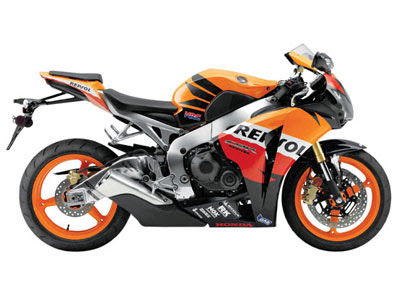The new 2010 model adds engine changes that provide an even smoother power delivery.
New for 2010 Honda CBR1000RR
- Increased-diameter flywheel for more inertia and improved performance.
- Redesigned license plate stay for easier removal on track days.
- New muffler cover for enhanced appearance.
- Exciting new colors: Pearl Orange/Light Metallic Silver and Red/Black. C-ABS model available in Black only.
- Compact, liquid-cooled DOHC 16-valve 999cc four-stroke inline four-cylinder engine features bore and stroke dimensions of 76mm x 55.1mm.
- Removable cylinder block with Nikasil-coated cylinders.
- Sixteen-valve cylinder head features 30.5mm intake and 24mm exhaust valves with a 12.3:1 compression ratio for efficient combustion and high horsepower.
- Larger titanium intake valves create a lighter valve train and feature double-spring design for optimum performance at high rpm.
- Intake ports use latest shot-peening technology that improves power and torque characteristics.
- Cam-pulser location between the middle cylinders allows a narrower cylinder head and frame.
- Direct shim-under-bucket valve actuation system ensures high-rpm durability and allows 16,000-mile valve maintenance intervals.
- Forged-aluminum thin-domed, high-strength pistons feature molybdenum coating for reduced friction.
- Lightweight nutless connecting rods.
- Iridium-tip spark plugs improve fuel combustion and performance.
- Dual Stage Fuel Injection (DSFI) (see Technology Section).
- 46mm throttle bodies feature Denso injectors with lightweight valving for faster reaction time and 12 holes per injector to optimize mixture atomization, combustion efficiency and power.
- Auto-enriching system is integrated into Programmed Fuel Injection (PGM-FI) module, eliminating the need for a manual choke.
- Idle Air Control Valve (IACV) minimizes torque reaction and smoothes response to small throttle changes through gradual reductions of air and fuel intake when the throttle is opened and closed.
- Ignition Interrupt Control system works with IACV and FI mapping to enhance driveability.
- Smaller and lighter ECU provides two 3-D fuel-injection maps for each cylinder and two 3-D ignition maps for cylinder pairs, creating ideal fuel mixture and spark-advance settings for superb rideability.
- MotoGP-derived twin-tunnel ram-air system allows a high volume of cooler air to the 9.7-liter airbox for linear power delivery and incredible engine performance.
- Butterfly valves inside the ram-air ducts open and close depending on throttle opening and engine rpm for optimum performance.
- Compact, low-mount exhaust system design reduces rear bodywork size and incorporates exhaust valve and catalyst, contributing to significantly improved mass centralization, and reducing roll and yaw inertia.
- High-capacity radiator incorporates twin cooling fans and allows a more compact cowl for reduced drag coefficient.
- Maintenance-free automatic cam-chain tensioner.
- Starter gears located on the right side to produce narrow engine that allows for increased lean angle.
- Patented slipper-clutch design uses a center cam-assist mechanism for easier actuation. Unlike an ordinary slipper clutch where the pressure plate moves from side to side, the Honda clutch moves both the center cam assist and the pressure plate to provide additional slipper effect.
- Nine-plate clutch is compact and tough, featuring durable friction plate material.
- Durable #530 O-ring-sealed drive chain.
- Iconic Honda Wing tank badge.
- Lightweight aluminum sidestand.
- Handlebars are repositioned forward for excellent ergonomics.
- High-capacity 400-watt AC generator (non-Combined ABS model).
- High-tech instrument display features tachometer and LCD readouts for speedometer, coolant temperature, odometer, two tripmeters, clock, mpg, average fuel consumption and reserve fuel used.. A low-fuel LED light and shift-indicator light are located above the LCD.
- Line-beam headlight features two-piece reflector design utilizing two H7 bulbs for optimum light distribution and unique compact design.
- LED taillights for lighter weight and improved appearance.
- Front turn signals integrated into folding aerodynamic mirrors.
- Plastic tank shell cover protects tank and airbox.
- Convenient ignition switch/fork lock for added security.
- Convenient push-to-cancel turn-signal switch.
- Maintenance-free high-capacity battery.
- Transferable one-year, unlimited-mileage limited warranty; extended coverage available with a Honda Protection Plan.
ENGINE
- Engine Type 999cc liquid-cooled inline four-cylinder
- Bore and Stroke 76mm x 55.1mm
- Induction Dual Stage Fuel Injection (DSFI)
- Ignition Computer-controlled digital transistorized with three-dimensional mapping
- Compression Ratio 12.3:1
- Valve Train DOHC; four valves per cylinder
- Transmission Close-ratio six-speed
- Final Drive #530 O-ring chain
- CHASSIS / SUSPENSION / BRAKES
- Front Suspension 43mm inverted HMAS cartridge fork with spring preload, rebound and compression damping adjustability; 4.3 inches travel
- Rear Suspension Unit Pro-Link® HMAS™ single shock with spring preload rebound and compression-damping adjustability; 5.4 inches travel
- Front Brake Dual radial-mounted four-piston calipers with 320 mm discs
- Rear Brake Single 220 mm disc
- Front Tire 120/70ZR-17 radial
- Rear Tire 190/55ZR-17 radial
- Rake (Caster Angle): 23.3°
- Trail 96.2mm (3.8 inches)
- Wheelbase 55.4 inches
- Seat Height 32.3 inches
- Curb Weight 439 pounds (Includes all standard equipment, required fluids and full tank of fuel--ready to ride.)
- Fuel Capacity 4.7 gallons, including 1.06-gallon reserve
- Colors: CBR1000RR ABS: Pearl Orange/Light Metallic Silver, Red/Black
- CBR1000RR ABS C-ABS: Black
- Curb Weight*: 439 pounds (CBR1000RR ABS) / 461.7 pounds (CBR1000RR ABS C-ABS)
- Includes all standard equipment, required fluids and full tank of fuel--ready to ride.
- Meets current EPA standards. California version meets current California Air Resources Board (CARB) standards and may differ slightly due to emissions equipment.









